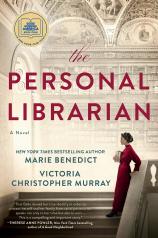The Personal Librarian
Review
The Personal Librarian
Whether you have been a tourist visiting the main attractions in New York City, grew up in one of the five boroughs, or simply dream of seeing Times Square and Lady Liberty, there’s no doubt you have heard of the Morgan Library. Founded by iconic banker J. P. Morgan in 1906, it began as a place for Morgan to keep his own private book collection, which had expanded to the point that it could no longer fit in his home. His books were not ordinary tomes, but rather a highly selective collection of illuminated manuscripts, famous authors’ original manuscripts, autographed and annotated scores from the likes of Beethoven and Chopin, and even some Renaissance artwork.
What you might not know about the Morgan Library is that, while Morgan himself was devoted to his cause and had a good eye for purchases, he was greatly aided in his endeavor by his personal librarian, Belle da Costa Greene. And what you definitely don’t know --- don’t worry, you’re not alone --- is that this esteemed woman of Portuguese descent was born Belle Marion Greener, a Black woman.
In THE PERSONAL LIBRARIAN, Marie Benedict, best known for her works uncovering the private lives of famous forgotten women, and Victoria Christopher Murray, author of STAND YOUR GROUND, introduce readers to Belle, who is forced to pass as white by her mother, whose light skin affords her opportunities that place her with the upper echelon of Manhattan’s elite. A devout reader and lover of art history, Belle is recommended to the role of personal librarian by Morgan’s nephew, Junius. Rather than wilting under the mercurial banker’s gaze, Belle is proud, confident and witty, and she soon earns his respect as both his employee and his colleague.
"Both a stunning tribute to an amazingly courageous woman and a searingly timely exploration of race relations in America, THE PERSONAL LIBRARIAN is an extraordinary novel that will have you frantically googling the key figures to learn more."
Taught to respect art and its history by her father, a proud Black activist, Belle is primed for the role. More importantly, she is hungry for it, driven not only by the income she needs to support her mother and siblings, but also by her respect and awe for the books and artworks that Morgan acquires. Though Belle has passed as white --- her olive tone explained by a “Portuguese grandmother” --- for a decade already, she tries a new tactic while working for Morgan, choosing to stand out rather than blend in. She wears bright dresses, attends the best galas, and shocks and delights her male coworkers with her wit and confidence.
In true Benedict fashion, we are immediately immersed in Belle’s world, full of glorious descriptions of illuminated manuscripts, silk- and velvet-lined libraries, and jewel-toned dresses worn at elaborate balls and galas. Her relationship with her employer provides the drama, as Morgan is demanding and stubborn but also proud and supportive of her. Belle herself succeeds at every task save one: acquiring Thomas Malory’s Le Morte d'Arthur by the printer William Caxton, the man credited with bringing the printing press to England. The volume Morgan wants is one of only two copies, and no one knows quite where it is, though Belle is certain that if anyone can find it, she can. As her hunt continues in the background, we watch as she upends entire auctions, forms relationships with collectors and gallerists, and puts her own mark on the Morgan Library.
All the while, the women’s suffrage movement simmers in the background, with Belle becoming a role model for other young women desperate to succeed in a world full of men. Through it all, Belle grapples with her own identity. Is it wrong, she wonders, to use the color of her skin to rise in the ranks as so many white people have done before her? Is she letting down her ancestors by hiding her Blackness and passing as white? And, most troubling of all, what will happen if Morgan and the rest of the art world discover her secret?
Although Belle makes quite a name for herself in Manhattan’s art scene, she is not without her detractors. Morgan’s daughter, Anne, makes constant references to the idea that Belle has “tropical” roots. Later, as Belle rises to her own fame, she takes on a lover who seems at first to understand her struggle, but then abandons her when she needs him most. Even her relationship with Morgan is occasionally contentious, full of “blink and you’ll miss it” moments of sexual tension and bouts of volatility. No matter the circumstance, Benedict and Murray’s depiction of Belle is unwavering, compelling and relatable. The authors have infused Belle with an innate sense of courage and power that makes her absolutely leap off the page, and her grapples with identity, race and otherness are full of deeply explored pain, timely commentary and an intoxicating sense of recklessness.
I am a longtime Marie Benedict fan, and though I have not read any of Victoria Christopher Murray’s works before, it is easy to see what she brings to this book. While Benedict is skilled at historical research and fiction writing, Murray validates and expands upon the racism that Belle experiences and observes. There is a timeliness here, an immediacy, that I am not sure Benedict could have found on her own, and I am grateful and laudatory of her decision to include a Black author to help bring Belle to life. The microaggressions and internal conflicts are written with spellbinding honesty and vulnerability, and without them I fear Belle never would have felt as real.
Benedict and Murray each include an Author’s Note in the book’s back matter, and it is a real treat to hear about their research processes, approaches to writing and the parts of Belle that felt most crucial to them. Interestingly, the real Belle destroyed many of her records in an attempt to hide her secret, but I feel that she would be honored and moved by the work that these authors have done to introduce her to the world once again.
Both a stunning tribute to an amazingly courageous woman and a searingly timely exploration of race relations in America, THE PERSONAL LIBRARIAN is an extraordinary novel that will have you frantically googling the key figures to learn more. I won’t be ready to part with Belle and her contemporaries for a long time after finishing this one.
Reviewed by Rebecca Munro on September 7, 2021
The Personal Librarian
- Publication Date: June 29, 2021
- Genres: Fiction, Historical Fiction
- Hardcover: 352 pages
- Publisher: Berkley
- ISBN-10: 0593101537
- ISBN-13: 9780593101537




